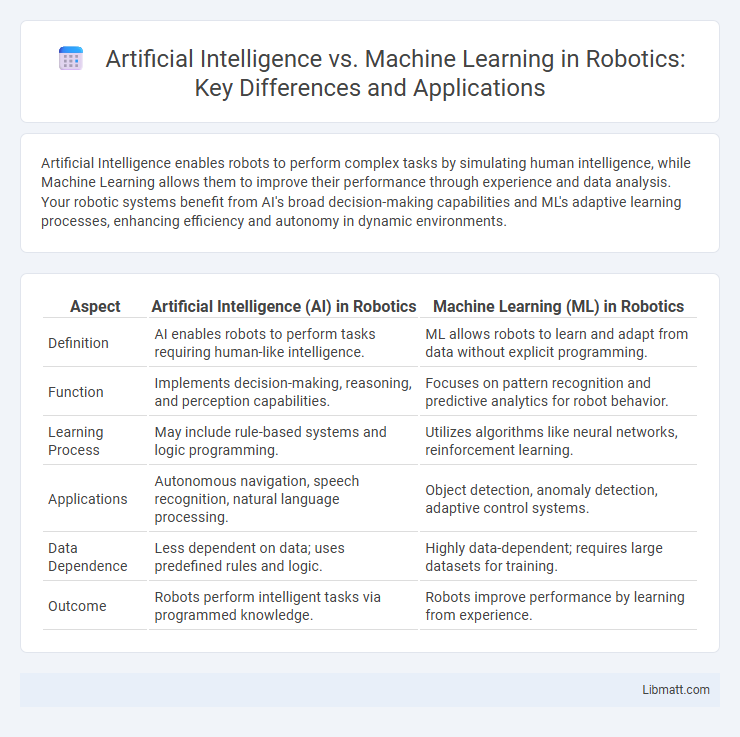Artificial Intelligence enables robots to perform complex tasks by simulating human intelligence, while Machine Learning allows them to improve their performance through experience and data analysis. Your robotic systems benefit from AI's broad decision-making capabilities and ML's adaptive learning processes, enhancing efficiency and autonomy in dynamic environments.
Table of Comparison
| Aspect | Artificial Intelligence (AI) in Robotics | Machine Learning (ML) in Robotics |
|---|---|---|
| Definition | AI enables robots to perform tasks requiring human-like intelligence. | ML allows robots to learn and adapt from data without explicit programming. |
| Function | Implements decision-making, reasoning, and perception capabilities. | Focuses on pattern recognition and predictive analytics for robot behavior. |
| Learning Process | May include rule-based systems and logic programming. | Utilizes algorithms like neural networks, reinforcement learning. |
| Applications | Autonomous navigation, speech recognition, natural language processing. | Object detection, anomaly detection, adaptive control systems. |
| Data Dependence | Less dependent on data; uses predefined rules and logic. | Highly data-dependent; requires large datasets for training. |
| Outcome | Robots perform intelligent tasks via programmed knowledge. | Robots improve performance by learning from experience. |
Understanding Artificial Intelligence in Robotics
Artificial Intelligence in robotics involves creating systems that can perform tasks typically requiring human intelligence, such as decision-making, problem-solving, and perception. It enables robots to interpret sensory data, adapt to new environments, and execute complex actions autonomously. Understanding your role in leveraging AI within robotics ensures enhanced efficiency and innovation in automated processes.
Defining Machine Learning for Robotic Systems
Machine Learning in robotic systems refers to algorithms that enable robots to learn from data and improve their performance autonomously without explicit programming. These algorithms analyze sensor inputs and environmental interactions to optimize decision-making and adapt to dynamic tasks in real-time. Machine Learning models, such as reinforcement learning and neural networks, significantly enhance robotic perception, movement, and task execution capabilities.
Key Differences Between AI and ML in Robotics
Artificial Intelligence in robotics encompasses the broader capability of machines to perform tasks that typically require human intelligence, such as reasoning, perception, and decision-making, while Machine Learning specifically refers to the methods enabling robots to learn from data and improve their performance over time. AI integrates various technologies including natural language processing, computer vision, and expert systems, whereas ML relies heavily on algorithms like neural networks and reinforcement learning to enable adaptability and autonomous improvement. Understanding these distinctions helps you leverage AI for general robotic intelligence and ML for specialized learning tasks, optimizing robotic applications across industries.
Core Applications of AI in Robotics
Artificial Intelligence in robotics powers core applications such as autonomous navigation, object recognition, and decision-making processes that enable robots to perform complex tasks with minimal human intervention. Machine Learning, a subset of AI, enhances these capabilities by allowing robots to learn from data, adapt to new environments, and improve performance over time through experience. Your integration of AI-driven perception and control systems significantly advances robotics in fields like manufacturing, healthcare, and autonomous vehicles.
How Machine Learning Powers Robotic Adaptation
Machine learning enables robots to improve performance by analyzing data and recognizing patterns, allowing autonomous adaptation to new environments and tasks. Through continuous learning algorithms, robots can optimize motor functions, decision-making processes, and sensor integration without explicit programming. This dynamic learning capability is essential for advanced robotic systems in unpredictable or complex applications, elevating flexibility and efficiency beyond traditional AI rule-based models.
AI-driven Robotics: Advantages and Challenges
AI-driven robotics offers significant advantages such as enhanced automation, improved decision-making, and the ability to perform complex tasks with high precision and adaptability. Challenges include the need for vast data processing capabilities, integration complexities, and ethical considerations surrounding autonomy and job displacement. Your implementation of AI-driven robotics can lead to increased operational efficiency but requires careful planning to address these technical and societal issues.
Machine Learning Algorithms Used in Robotics
Machine learning algorithms such as reinforcement learning, convolutional neural networks, and support vector machines play a pivotal role in robotics, enabling autonomous robots to process sensory data, adapt to dynamic environments, and improve task performance over time. Reinforcement learning algorithms allow robots to optimize actions through trial and error, while convolutional neural networks excel in visual recognition tasks critical for navigation and object manipulation. Integrating these machine learning techniques enhances the precision, efficiency, and adaptability of robotic systems across industries like manufacturing, healthcare, and autonomous vehicles.
Integration of AI and ML in Modern Robots
Integration of Artificial Intelligence (AI) and Machine Learning (ML) in modern robotics enhances autonomous decision-making and adaptive behavior, enabling robots to learn from data and improve performance in real time. Advanced AI algorithms process sensory inputs while ML models optimize task execution, resulting in increased precision, efficiency, and versatility across manufacturing, healthcare, and service industries. Your robotic systems benefit significantly from continuous learning capabilities, allowing seamless adjustment to dynamic environments and complex tasks.
Future Trends: AI and ML Collaboration in Robotics
Future trends in robotics emphasize the seamless collaboration between artificial intelligence (AI) and machine learning (ML) to enhance autonomous decision-making and adaptive behaviors. Integrating AI's cognitive reasoning with ML's real-time data processing accelerates robotic learning, enabling faster responses in dynamic environments. Advancements in AI-driven neural networks and reinforcement learning algorithms will drive smarter, more efficient robots capable of complex task execution and human-robot interaction.
Choosing the Right Technology: AI vs ML for Robotics
Choosing the right technology for robotics depends on project goals, where Artificial Intelligence (AI) offers broader autonomy and decision-making capabilities, while Machine Learning (ML) enables robots to improve performance through data-driven learning processes. AI systems integrate perception, reasoning, and planning to handle complex tasks, whereas ML algorithms specialize in adapting to changing environments by analyzing sensor data and refining actions. For applications requiring adaptive behavior and continuous improvement, ML provides the necessary tools, but for strategic problem-solving and intelligent control, AI delivers comprehensive robotic intelligence.
Artificial Intelligence vs Machine Learning in Robotics Infographic

 libmatt.com
libmatt.com